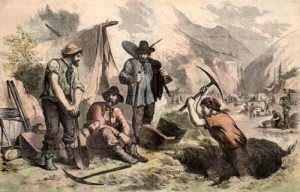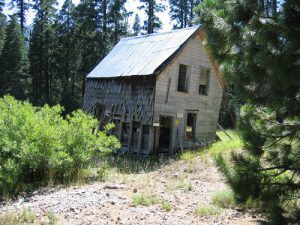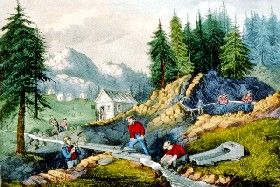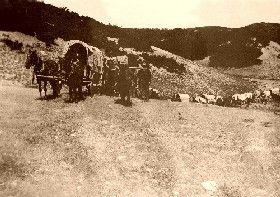Butler’s Forgotten Claim
In the heart of Mother Lode country, Amador County, California, was once crawling with prospectors. Near the very place where James Marshall first discovered gold at Sutter Creek, another profitable claim was being worked that may continue to hold large amounts of gold buried close by.
At the foot of a deep gorge coming out of the mountains was a claim first owned by a group of African-American miners. The river was soon dammed so the miners could work the smooth channel. However, there was no holding place for the gold, so the entire party soon left – except for a man named Butler.
Seeing potential in the claim, Butler soon borrowed $600 from a man known as Uncle Pompey and opened another claim a little lower down in the bend.
Butler’s instincts were right, as his gold pan would be filled with gold nuggets after a day’s work. Some said a day’s work with a rocker would produce as much as $50,000 in gold. As word of the rich find got out, several men, anxious to have a share, hunted down Butler’s former partners, inducing them to sell their interests in the claim. This soon resulted in lawyers and lawsuits, all wanting a piece of the action.
Butler, a simple prospector, was overwhelmed by all the controversy and soon took sick with a fever and died. Afterward, it was found that Butler had about $80,000 on deposit at Mokelumne Hill and a similar amount at Sacramento. However, his friends said that he was often known to bury his profits close to the site of the claim.
Today, those buried caches are thought to be still hidden in Amador County.
Gold Coins in Clear Creek
In the 1850s, a group of Mormon wagons was passing through the fertile valley of Redding, California, on their way to the tiny settlement of Horsetown. However, they first had to cross Clear Creek, usually, a quiet little stream, to get there. However, when they arrived, Clear Creek was nothing but quiet; instead, it was a muddy torrent of raging floodwaters running off the nearby mountains. Forced to stop on the creek’s banks, they waited several days for the creek to settle down to its normal, easily crossable state.
However, they were impatient to get to their destination and didn’t wait long enough. When the flash flood waters had slowed but were not yet calm and shallow, they decided to cross. Most of the wagons safely made it across the river, but one wagon, belonging to Mr. Bishop, met with disaster. Entering the swollen waters just a little downstream from the others, he quickly found the creek deeper in that particular area.
Soon, one of the wagon wheels fell into a deep hole, and without warning, the wagon tipped on its side. Able to unhitch his team of horses, Bishop and the animals made it to safety, but the wagon was carried downstream.
The incident was then forgotten for decades until 1910, when a prospector named William Dreestelhorst found a ten-dollar gold coin in his sluice box. The coin was stamped with the initials “SMV,” dated 1841, and the words “California Gold” were inscribed around the rim. This meant the coin was privately minted by an assayer and was of the very same type the Mormons had lost some 60 years previously.
This began yet another search of Clear Creek, but again, no one found the lost cache of coins. Many believe that the lost Mormon treasure continues to be hidden along the banks of Clear Creek southwest of Redding, California.
Gold Coins at Bloody Springs

California Gold Miners
As in many places of the American West, the friction between the scores of men entering California during its Gold Rush days and the Indians was often bitter. Weary of the white men continuing to encroach upon their lands, the danger to travelers was very great when entering California from the northeast.
As the California Trail proceeded south into the Sacramento Valley on the Pit River route, wagon trains and travelers were often ambushed by the natives. Bloody Springs, at the lower end of Spring Gulch, was the scene of numerous attacks, hence its name. Smaller groups were often wiped out.
On one such occasion, an entire emigrant train was massacred by the Indians. Only one man survived to tell the story. Finally, he made his way to Fort Crook, telling of how the train was carrying approximately $60,000 in $20 gold coins. Before he made his getaway, the man witnessed the Indians competing to see who could throw the shiny disks across the Pit River Gorge. The “contest” continued until each and every one of the gold coins was either in the river or lodged into the rock walls of the gorge.
Today, an occasional gold piece is still found at Bloody Springs in Lassen County. Bloody Springs is located a few miles southeast of Pittsville above the banks of the Pit River.
Poker Flat Cache

Poker Flat, California
From the 1850s to the 1880s, Sierra County, California, was crawling with prospectors in search of gold. The northernmost region of California’s mother load, dozens of mining camps, with such names as Poverty Hill, Queen City, Port Wine, and Poker Flat, sprouted up as prospectors searched for the glittering rocks in the streams of the area. By the late 1850s, hydraulic mining began in the region, which continued through the 1880s.
Undoubtedly, many a prospector and mine owner made their fortunes during these affluent times. But they were not the only ones. Those storekeepers who catered to the miners’ needs also profited. One such man who gained wealth running his retail establishment was named Jerome Peyron. The storekeeper was known to have made frequent trips into the hills behind his store in Poker Flat, where he buried his money. However, when a Mexican Gang heard of Peyron’s hidden money, they converged upon his shop, demanding to know its location. When Peyron refused to tell them, he was murdered by the gang.
To this day, Peyron’s buried cache has not been found.
© Kathy Alexander/Legends of America, updated January 2023.
Also See


